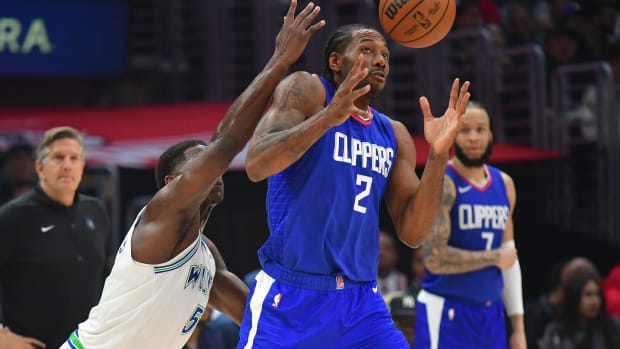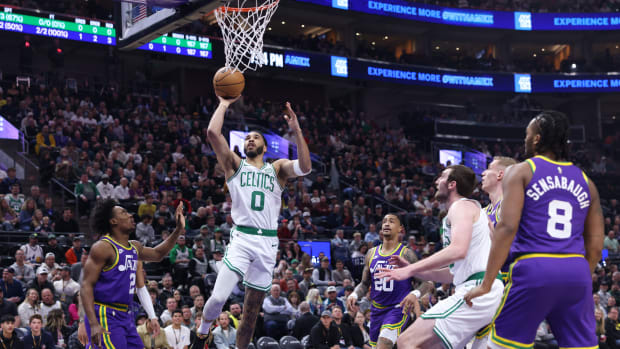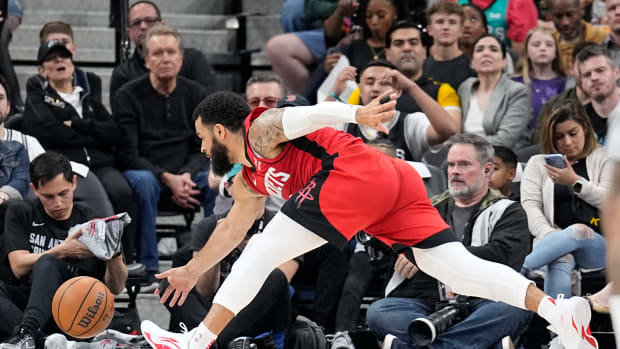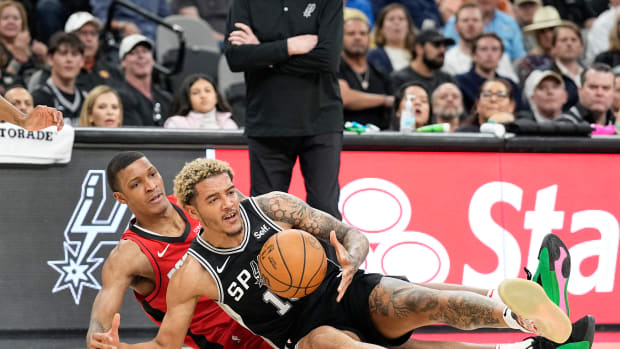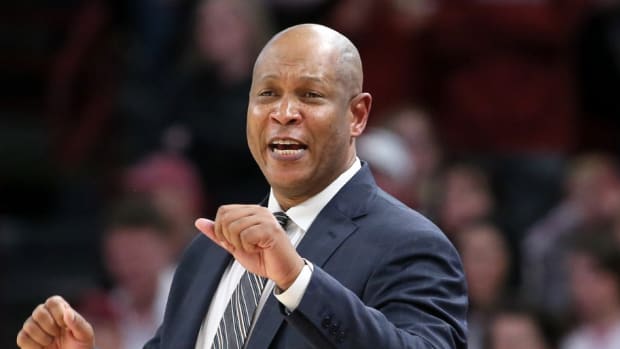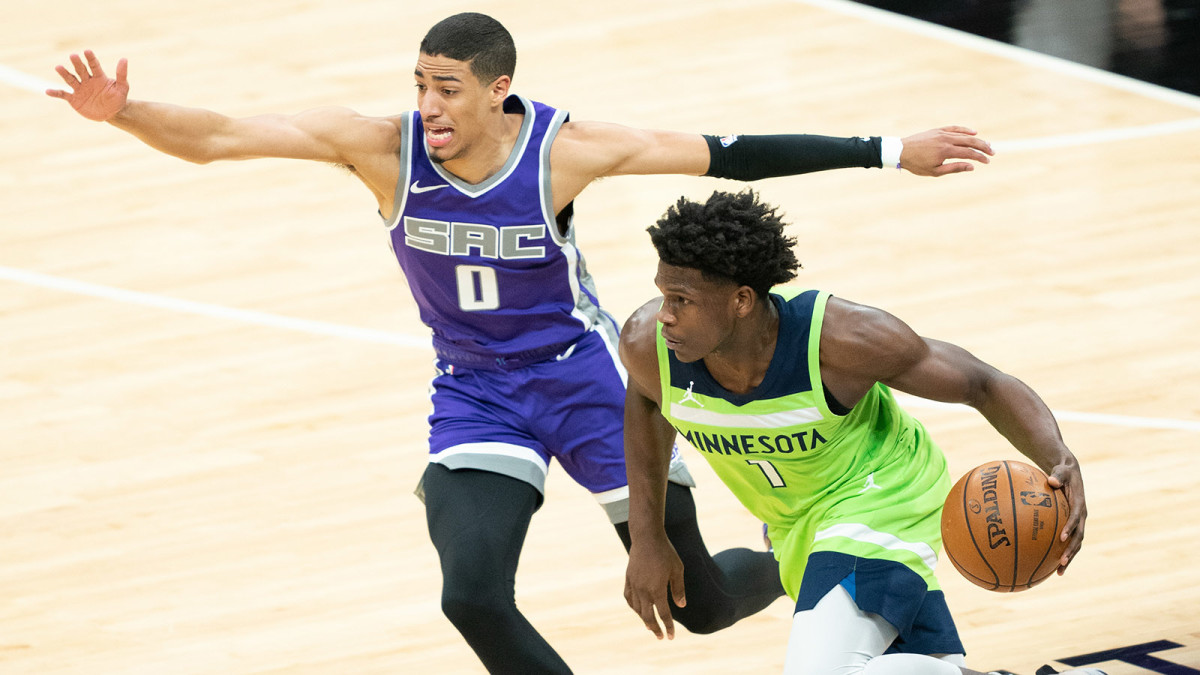
10 Parting Thoughts on the 2020 NBA Rookie Class
With just a handful of days left in the regular season, the NBA’s rookies are close to … no longer being rookies. Here are my final thoughts on the season that was, some of the major developments and what’s coming next.
1. It’s critical to preface everything in this column with a reminder that player development can be aggressively nonlinear. And while there are certainly elements of a player’s rookie year that can be strongly indicative of their future, it still isn’t enough time to form complete conclusions. It’s fair game to consider the way things are trending at the moment, but I’m going to try and hold off on totally bashing draft picks or burying any rookies prematurely, particularly after a shortened season that offered little in the way of playing opportunities for a majority of players, with a compressed G League schedule abetting the issue. This was a weird year for everyone. Carry on.
2. The debate between LaMelo Ball and Anthony Edwards isn’t over. That’s a great thing: Both Rookie of the Year frontrunners significantly exceeded expectations this season and should have extinguished predraft concerns surrounding the quality of the top of the draft. As you may remember, there was widespread trepidation around the NBA, and a sense that nobody really wanted the pressure of picking first. The Timberwolves postured until essentially the last second that they were trying to trade the selection. It’s easy to forget now that both have hit their stride, but Edwards and Ball—the top two prospects on Sports Illustrated’s Big Board, and many others—were highly polarizing across the league. Skeptics were unsure how effective Edwards’s style of play would be and concerned about his feel as well as how much work it would take for him to approach his considerable ceiling. Ball’s jump shot, struggles to score at the rim, and an unusual pathway to the NBA concerned teams to various degrees. He ultimately did little to sway Minnesota’s front office after a much-publicized predraft meeting in October.
Many of those concerns now feel silly and misplaced. Ball has been a transformative force for the Hornets and a catalyst for an unlikely run to a playoff spot, which should presumably give him the edge for Rookie of the Year. He’s emerged as one of the NBA’s flashiest passers while shooting a more than respectable 36% from three-point range and effectively limiting turnovers. Edwards is averaging nearly 19 points a game and perhaps beginning to turn the corner toward optimal efficiency, although that type of journey for volume scorers tends to require a few years to play out properly. If the NBA redrafted today, there are many who would prefer Ball’s playmaking upside, but this is something we’ll be revisiting over the next few seasons. Without rehashing this discourse to death, the good news is that Ball and Edwards look like potential All-Stars, and that the returns from last year’s draft look much more promising than most expected.
3. At this point, revisiting Tyrese Haliburton’s fall to No. 12 is kind of tiresome. Brace yourself to hear about it for the next decade. His season was cut short with a knee injury, but to the naked eye, Haliburton was arguably the biggest rookie revelation of the season. That being said: If you obsessively watched him play more than two years at Iowa State [raises hand], nothing he accomplished this season should have been that surprising. The question of how far he’ll be able to carry a team as its best player remains, but Haliburton may never have to be, and he’s paired for the long haul with De’Aaron Fox—one of the league’s best guards when it comes to putting on pressure in the paint, and an ideal partner.
There’s probably a point to be made here about the value of imagination when it comes to scouting. If you looked at Haliburton through a narrow lens as a point guard, his flaws felt more glaring. He may never get to the rim against set defenses or draw tons of fouls, and his shooting mechanics will limit some of his ability to play in isolation. But working out of ball reversals and operating against bent defenses, his exceptional vision, instinctive passing and reliable jumper make Haliburton extremely dangerous. He’s going to continue getting better, and stylistically, he’ll never really have to change. His theoretical upside isn’t quite on par with Edwards and Ball, but it’s not totally wild to think Haliburton could still have the best career of the three.
4. Three once-touted prospects will enter their sophomore seasons under a particularly tight microscope: James Wiseman, Obi Toppin and Deni Avdija. It’s fair to give all three incomplete grades this season: Wiseman and Avdija sustained season-ending injuries and Toppin has been buried on the bench for the shockingly relevant, playoff-bound Knicks. But all three will need to show some signs of life to better justify their draft position, and it’s fair to wonder what type of progression we should really expect.
The Warriors are still high on Wiseman—they kind of have to be, to be fair—and it’s true that bigs generally take longer to develop. In retrospect it was probably foolhardy to think Wiseman was going to be a highly effective rookie, considering he basically lost a year of development after leaving Memphis, and that he was never an especially intuitive player as a prep star. It doesn’t seem overly fair to pile on here. It’s going to take him a while. But Wiseman will need to start making strides in smaller areas he can control like screening and defensive positioning to add positive value as the Warriors figure out the best ways to get him involved on offense.
It’s hard to know whether or not to be concerned about Toppin, who’s already 23 and playing a minor role in which he hasn’t been especially productive. Tom Thibodeau is notoriously rookie-averse, Julius Randle turned into an All-Star and the Knicks are pushing full bore into the playoffs. This hasn’t been an optimal growth situation for Toppin, who struggles defensively and beat up on lesser competition in the Atlantic 10 last year. But Thibodeau has given a longer leash to fellow rookie Immanuel Quickley (a great grab for New York at No. 25). Still, Knicks brass heavily coveted Toppin during the draft process. They’re invested. And they’re going to have to find minutes for him next year or risk him losing a good chunk of his market value, which has already taken a hit. Bottom line: Toppin is a poor fit next to Randle—and that’s going to put New York in a tricky spot as it prepares to pitch big-name free agents in the coming years.
I personally felt Avdija was a bit overhyped last year coming over from Israel, but teams were high on him as a long-term starting-level player. His season ended early with a hairline fracture in his right leg, but he struggled to score efficiently and was an average jump shooter, which was predictable. The Wizards didn’t expect him to be on the board at No. 9, where he looked like a nice value pick, but he may prove to be a bit of a clunky fit with Rui Hachimura, who’s similarly a bit stuck between forward spots on offense and isn’t a player you want handling the ball all that much. Avdija was never expected to be more than an average defender, which places some stress on his offensive skills panning out and allowing him to be a versatile piece. He had some moments this year, but his role was highly tertiary in Washington’s guard-driven offense. There will be added pressure on him to showcase his playmaking and improve his jumper moving forward.
5. As for some of the other early lottery selections, some extra patience is probably warranted. Patrick Williams looked his age this season for the Bulls, but it does feel like there’s a lot for him to unpack long term. Isaac Okoro leads all rookies in minutes per game and played a big role for the Cavaliers but struggled to shoot. Both of those outcomes were fairly predictable. Onyeka Okongwu was hurt early in the season and hasn’t played much as the Hawks prepare for the playoffs. Killian Hayes missed most of the season for the Pistons. I’m still curious about all four players, and not ready to worry too heavily about any of them. But I’d try to keep expectations realistic.
6. Say what you want about shameless tanking, but we’re about to hit another round of teams’ going full teardown. The Thunder and Pistons entered this year with no designs on competing for the playoffs. The Rockets and Magic have since joined them. And it’s worth considering (if you can stand the losing) the smaller-scale benefits these franchises have reaped from simply being able to hand young and unproven players real minutes early in their careers.
The Thunder are losing, a lot—they’ve literally won once since April 2—but at least they’re trying stuff in the meantime. This is the NBA’s weirdest sideshow. In the long run it’s probably going to benefit guys like Darius Bazley and Luguentz Dort, who are stretched to their absolute limits as scorers within Oklahoma City’s structure. Anyone who knows what Aleksej Pokusevski will be in two years is lying. Théo Maledon looks like a nice value pick. Moses Brown has started to find some footing in the NBA. It’s hard to know what the long-term impact of all the losing will be—and it’s honestly hard to say if the plan is even working—but it’s certainly something. In a year with no G League, at least the Thunder have a strong feel for what’s on the roster.
Detroit has gotten great early results from Isaiah Stewart and Saddiq Bey, who were always going to be two of the more league-ready rookies as far as mentality was concerned, but look like legitimate future role players. The Hayes pick will ultimately define this draft—Pistons boss Troy Weaver may have been higher on Hayes than any top executive in the NBA—but it looks like Detroit nailed its other two first-rounders. And again those guys have gotten valuable minutes that may not have been readily accessible elsewhere. The Pistons will need a few years to turn the roster over to lay a blueprint, but those early results are encouraging.
Houston and Orlando are set to enter next season in the same boat. The Magic offloaded everyone at the deadline. The Rockets will probably try really hard to move John Wall, whose price tag may be prohibitive. The tanking renaissance has begun. Of course, front offices have to be able to stomach the losing and feel confident enough in their job security to pull something like this off, in practice. And there’s no guarantee that the endpoint of a teardown is anywhere close to what you’d want. But with a large portion of the league trying to compete now, watching the other teams turn into their own skids should remain pretty compelling.
7. One item on my mind with the ’21 draft nearing is how teams will approach drafting older prospects and how aggressively they’ll do it. Should the Knicks’ mothballing Toppin in year one be a cautionary tale? Is it apples and oranges? Player development is nonlinear, but the history of success with teams drafting advanced-age lottery picks is pretty poor. Toppin, at 22 years old on draft night, was the oldest top 10 pick since Wesley Johnson went fourth in ’10. Players like Johnson, Kris Dunn (’16) and Trey Burke (’13) have had NBA careers but certainly didn’t live up to the hype. Buddy Hield (’16) can be viewed as a success story, but he’s been a volume scorer on mediocre teams, and he’s now 28 with little to show for that (beyond a large second contract, to his credit). History says taking college upperclassmen in the lottery is often suboptimal. From a team perspective there simply isn’t an encouraging precedent, which is why it so rarely happens.
To be fair, teams can miss on a player of any age if they aren’t careful. But this year, Baylor’s Davion Mitchell (who turns 23 in September) and Gonzaga’s Corey Kispert (who turned 22 in March) are both tracking as possible lottery selections, and are polarizing evals for discerning observers. Chris Duarte, who turns 24 in June, may get drafted in the 20s. All three are very good college players. How teams measure the risk in those particular cases should be worth watching. Memphis has had early success with Desmond Bane and Xavier Tillman, but those were the 30th and 35th picks—simply landing an NBA-caliber player in that range is a win. In the lottery the expectations are a little higher, and the assigned slot value is much more expensive.
8. O.K., so I have one lasting gripe from last year’s draft. I still don’t understand why the Suns drafted Jalen Smith at No. 10. Phoenix’s emerging as one of this season’s great success stories pretty much quieted criticism of that pick. Maybe he breaks out next season. In their defense, they weren’t the only team that was high on Smith (I viewed him as a fringe first-rounder, but that’s not really the point). But situationally, it was hard to justify on draft night: it wasn’t a true-need pick for Phoenix; it came with optimism that Smith could transition to playing a perimeter-oriented power forward role, and it happened with Haliburton and Kira Lewis still on the board, both of whom would have made a lot of sense, for different reasons. (Imagine Haliburton in three-guard lineups with Chris Paul and Devin Booker, and Mikal Bridges sliding to the four. Whew.)
Coach Monty Williams commented to the press last month that the Suns were trying to groom Smith to play like Dario Šarić—which, frankly, coming out of college would have sounded preposterous. Deandre Ayton isn’t going anywhere, which not only means that Smith has to play the four on offense, but he’s also going to have to defend them to play the floor-spacing role that Phoenix envisions alongside the taller Ayton. The whole concept didn’t make any sense to me then, it doesn’t make any sense to me now and I don’t know if Smith is ever going to be a significant player for them. That particularly stings considering the uptick the Suns have enjoyed this season with Paul, who doesn’t appear to be slowing down, and is under contract for one more season.
9. There have been a handful of late second round/undrafted success stories worth noting, chief among them Houston’s Jae’Sean Tate, who has emerged from the Rockets’ strange circumstances as a legit rotation guy after spending two years overseas. Tate has been a starter for most of the season and has been productive with his opportunities, emerging as a sort of spiritual small-ball successor to the departed P.J. Tucker. The next step for him will be starting to shoot the three more consistently.
The Rockets have also gotten some good moments from 52nd pick Kenyon Martin Jr., who still has a ways to go but clearly has the tools to carve out a niche moving forward. 58th pick Paul Reed won G League MVP and looks like good value for the Sixers. Among the best undrafted finds: New Orleans’s Naji Marshall and Cleveland’s Lamar Stevens, who have both been converted to full contracts.
10. Rookies I’d personally like to see a lot more of next season: Devin Vassell (the Spurs need to play him more), Tyrese Maxey (has had some good moments, but has been in and out of Philly’s rotation), Lewis (might be the point guard of the future in New Orleans) and R.J. Hampton (playing well for Orlando to end the season, but will presumably slide in behind Markelle Fultz in the fall). Until then there’s another draft to worry about, and it’s less than three months away.
More NBA Coverage:
• Triple Doubles: Hoops' Holy Grail or Statistical Anomaly?
• The Kings Are Building for the Future
• How the Rockets Unlocked Kevin Porter Jr.
• What Happened to Player-Coach Relationships?






























